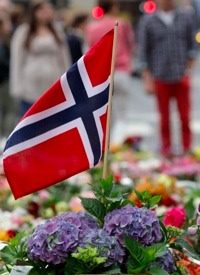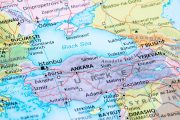
Confusion surrounding the bombing and the shooting has only grown as more information — sometimes contradictory — continued to trickle out. At the top of the list are concerns that Anders Behring Breivik may have had accomplices.
According to multiple witnesses who survived the shooting rampage on the island of Utoya, there were at least two shooters. Breivik, in police custody since last week, has admitted to his role in the massacre. But survivors also described a “dark-haired” shooter who, unlike Breivik, was not wearing a police uniform.
Norwegian authorities did not rule out that possibility in the early days following the tragedy. More recently, however, police spokesman Henning Holtaas said that "earlier witness accounts indicated that there were several shooters, but nothing in the evidence we found on the island backs that up."
But even if there were no direct accomplices, claims by Breivik that there are other “cells” in Europe waiting to unleash havoc have also attracted scrutiny. A 1,500-page “manifesto” attributed to the terrorist hints at the possibility that Breivik believed he was part of a modern-day “crusade” to expel Muslim immigrants from Europe under the banner of a new "Knights Templar."
Law enforcement and intelligence agencies across the continent, and particularly in Norway, are reportedly still investigating the possibility. But so far, according to the AFP news service, officials have not publicly acknowledged that any evidence has been uncovered indicating the existence of co-conspirators.
A series of news reports with very few details in the days after the shooting, however, noted that at least six other suspects in Norway had been arrested at a run-down building in connection with the attack. They were all reportedly released without charges. And so far, authorities are saying that Breivik appears to have acted alone.
"It’s a unique case. It’s a unique person. He is total evil," Norwegian Police Security Service director Janne Kristiansen told The Associated Press. "On the information we have so far, and I emphasize so far, we have no indication that he was part of a network or had any accomplices, or that there are other cells."
But anti-immigration groups, especially in the United Kingdom, are reportedly under intense scrutiny. In Finland police arrested a young man on Thursday who they say had purchased a type of fertilizer that could be used in making bombs, though it is not believed that the suspect was in any way connected to the attacks in Norway.
Still, authorities all across Europe are said to be on high alert for potential threats inspired by Breivik’s rampage. "Clearly, one major risk is that somebody may actually try to mount a similar attack as a copycat attack or as a way of showing support," a European Union terror adviser told the AP.
Of course, questions about how the tragedy could have been averted — as well as how to prevent similar attacks in the future — are attracting headlines, too. Particularly significant have been reports that it took police over an hour to arrive at the island where Breivik was slaughtering young political activists.
The Norwegian government recently announced the formation of an independent commission to investigate everything related to the attack, including the police response. But questions about the nation’s strict gun-control laws, lenient sentencing, and political climate have all been raised since the massacre.
Whether Breivik is sane or not is also being hotly debated. His lawyer insists that he must be insane, but other experts believe he was in fact a cold-blooded, intensely calculated murderer who understood exactly what he was doing. A medical team will reportedly investigate the matter, and the findings will likely play an important role in determining Breivik’s future.
If he is found to be insane, he could be placed in a mental institution instead of a prison. But, if doctors determine that he is mentally competent, prosecutors may seek a jail term of up to 30 years.
Reports that Breivik was using steroids – sometimes linked to increased aggression and violence – have raised questions as well. However, it is not clear if the issue will affect Breivik’s fate in a significant way.
On top of all that, conspiracy theories have been running rampant since the day of the attacks. Questions about the alleged addition of “Christian” and “conservative” to a Facebook profile attributed to the killer after the massacre have been at the forefront of the discussions.
But of course, like with other terror attacks, speculation about the possibility of it having been a “false-flag operation” is blazing across the blog-o-sphere. Theories about who else may have involved in the terror, however, are literally all over the map.
What lessons can be learned from the tragedy, if any, is another debate that is heating up as time goes by. Policy discussions surrounding the attack will almost certainly continue to intensify in the coming months — in Norway and around the world.
For now, large swaths of the media and certain special-interest groups are being criticized for attempting to score political points in the aftermath of the attack. Almost immediately after the tragedy was reported, the “blame game” began to spiral out of control.
Fears that there could be a backlash against individuals, political parties, and organizations espousing ideas resembling the killer’s are also growing. Time will tell whether or not the worries were justified.
Photo: AP Images
Related articles:



